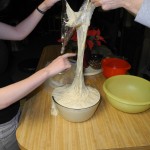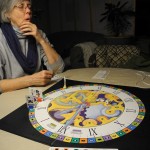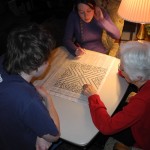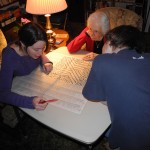Author: leh
Puzzling Out Christmas Eve with Grandma Janet
This year THE OREGONIAN published a massive 2&1/2 page crossword puzzle on a 2012 cultural theme. So the resident puzzlers took it along to enlist Grandma Janet’s legendary crosswording skills as the highlight of Christmas Eve … supplemented by cookies and tea, of course.
Cookie Madness
 In a frenzy of cooking — actually Ivi has been creating culinary delights in the kitchen every day of her winter vacation — Ivi prepares cookie assortments to gift Grandma Janet and her friends, braving the cold nights to make walking deliveries around the neighborhood.
In a frenzy of cooking — actually Ivi has been creating culinary delights in the kitchen every day of her winter vacation — Ivi prepares cookie assortments to gift Grandma Janet and her friends, braving the cold nights to make walking deliveries around the neighborhood.
The ingredients in some of these are fairly exotic, but I can’t shed much light on them without Ivi’s help.
Purely Pacific Northwest
Something from CNN Report:
Anybody Old Enough … ?
 … to remember what computers used to be like 40 – 50 years ago? click on, then regress to enter your search …
… to remember what computers used to be like 40 – 50 years ago? click on, then regress to enter your search …
What If?
Now, we know there is a lot of political polarization around these days, but this Slate piece attempts to explore the possible outcome of a new civil war: http://www.slate.com/blogs/quora/2012/11/27/civil_war_who_would_come_out_on_top_if_the_united_states_all_declared_war.html?wpisrc=obnetwork
How Healthy Is Your State?
Find out here or click on image.
Small Demons
Femto-Photography
My so-far favorite Ted Talk of all time …
By the way, whenever we reach a family impasse when trying to decide upon which DVD to play or which Netflix movie to stream, we default to random Ted Talks to keep things moving in a positive direction. They consistently turn out to be well worth the time spent. And sometimes they can take your breath away, like the one above.
QuickSort in Dance
Nik may be one of the few readers of this blog (if he actually reads it) who might appreciate what the QuickSort algorithm is. It is a venerable staple of computer programming to quickly sort the values in an array (expressed as a range of numbers you are working with). Basically it works by choosing a “pivot” or a member of the array and creating “partitions” to group the remaining numbers into those greater in value than the pivot and into those lesser in value. Then progressive iterations ultimately determine and re-arrange and re-attach the numbers into a new array that is sorted from lowest to highest (using a “pointer” to show the movement through the array). If you want a much more complete and proper explanation of quicksort, try http://en.wikipedia.org/wiki/Quicksort or http://www.cs.auckland.ac.nz/~jmor159/PLDS210/qsort.html or http://rosettacode.org/wiki/Sorting_algorithms/Quicksort or lots of other computer science/computer programming references (just try Google if you don’t understand the explanation at any of these links).
Anyway, I am told that a Romanian art student who minored in computer science devised a way to illustrate the QuickSort algorithm through the medium of Hungarian folk dancing (albeit a bit slower than a computer can do it). And here it is (note how the pointer is represented by the changing of the hat!):
But wait! There’s more! See more of your favorite computer sorting algorithms — BubbleSort, SelectSort, MergeSort, ShellSort, etc. — dancing their hearts out here:












